Watermelon, often perceived as too sweet and thus unhealthy, is actually a nutritious choice worth considering. This article explores how many calories in a Watermelon, providing a clearer understanding of its place in a healthy diet. So if you are craving watermelon but worried about the calorie content, read on!
1. Why Should You Know Watermelon’s Calorie Content
Understanding the calorie content in foods is essential for effective weight management, whether the goal is weight loss or muscle gain. Calorie counting involves tracking the amount of food consumed and comparing it to the body’s daily calorie requirements.
To lose body fat, one must consume fewer calories than their daily requirement, creating a calorie deficit. Conversely, gaining muscle mass requires a calorie surplus, where more calories are consumed than expended.
Recognizing the calorie content in foods is crucial for achieving these fitness goals, as caloric intake is directly linked to weight gain or loss. Therefore, accurately hitting your calorie target plays a pivotal role in managing body weight.
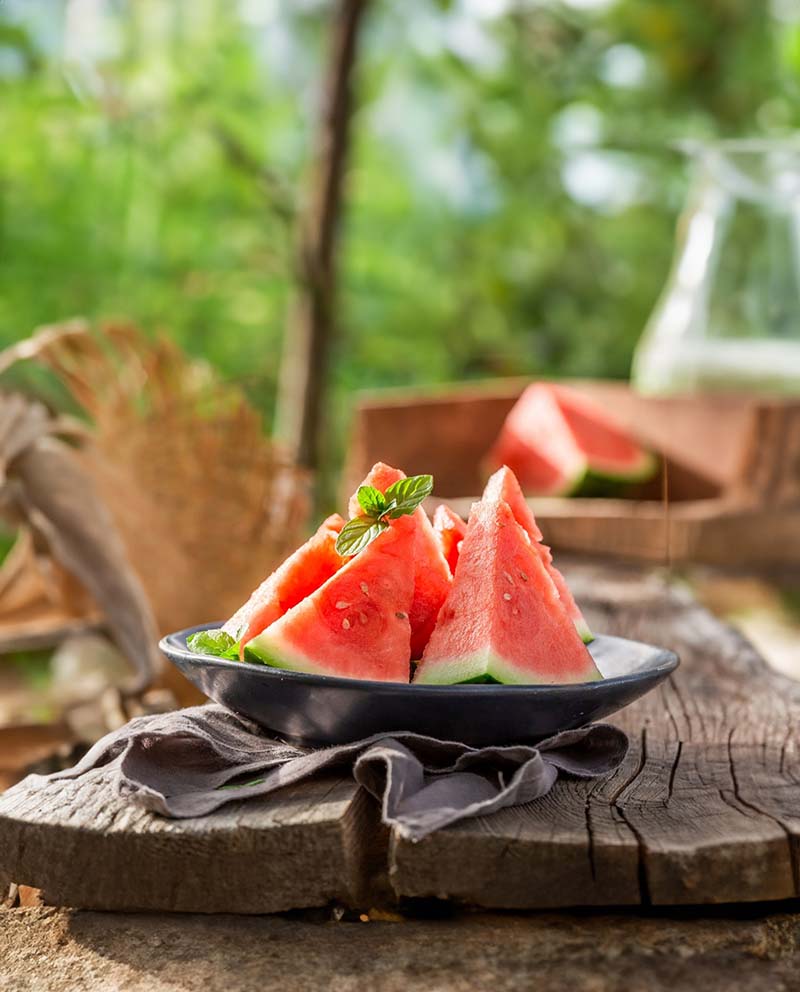
1.1 Calorie Content in a Whole Watermelon
You might be surprised to learn that even a whole watermelon doesn’t meet the average daily calorie intake. According to FoodData Central from the United States Department of Agriculture (USDA), a sizable watermelon, measuring about 15 inches in length and 7.5 inches in diameter, contains approximately 1,360 calories.
The majority of these calories come from carbohydrates, predominantly natural sugars like sucrose, fructose, and glucose. These sugars contribute to watermelon’s delightfully sweet taste. Despite its sugar content, a watermelon has a relatively low carbohydrate count, which means consuming it is unlikely to cause significant spikes in blood sugar levels.
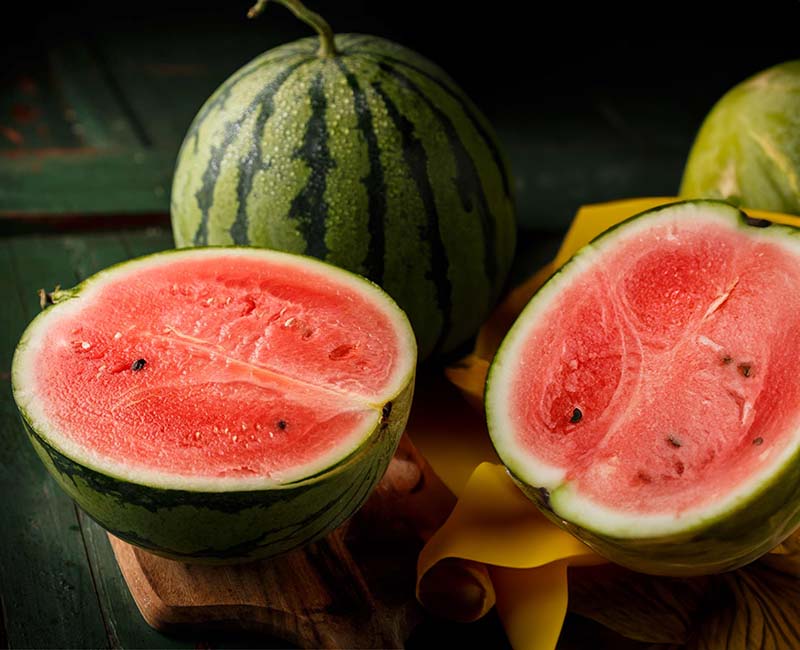
1.2 Calorie Content in a Slice of Watermelon
When it comes to individual slices, the caloric impact is minimal. A single slice of watermelon, roughly 1/16 of a whole watermelon of 15 inches by 7.5 inches, holds just 86 calories, as per USDA data. This makes it a low-calorie option for those keeping an eye on their daily calorie intake.
1.3 Calorie Content in a Cup of Watermelon
If you’re counting calories by the cup, a cup of diced watermelon, weighing about 152 grams, is even more calorie-friendly. This portion contains only 46 calories, alongside 0.9 grams of protein, 11.5 grams of carbohydrates, and a negligible 0.2 grams of fat. This makes diced watermelon a superb choice for a refreshing, low-calorie snack.
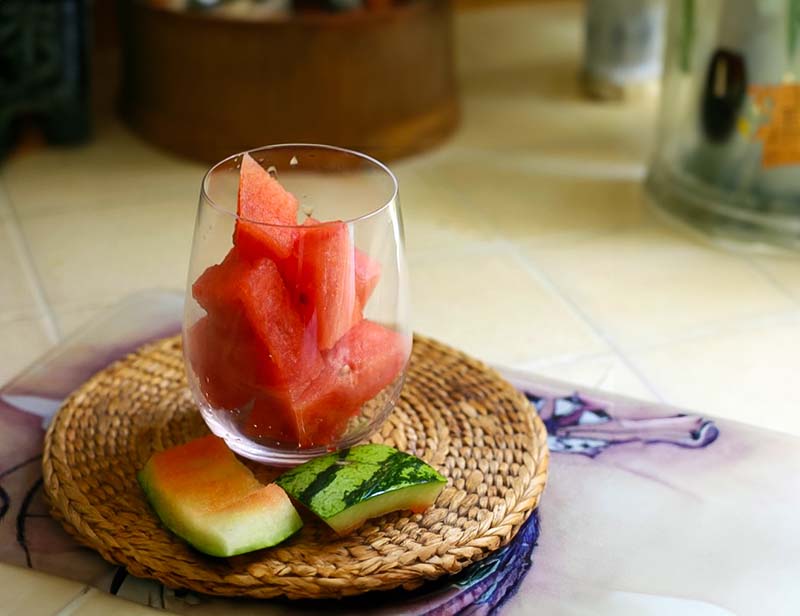
2. Nutritional Composition of Watermelon
Watermelon isn’t just a delicious and sweet snack; it’s also packed with nutrition. In a single cup of watermelon, you get:
- Only 46 calories
- 12 grams of carbohydrates
- 865 international units (IU) of vitamin A (0.26 milligrams)
- 12 milligrams of vitamin C
- 170 milligrams of potassium
- 0.1 milligrams of vitamin B6
- No fat, cholesterol, or sodium
These nutrients are beneficial for your health. Vitamin A boosts skin and eye health. Vitamin B6 is essential for breaking down protein, supporting immune function, and maintaining healthy nerves. Vitamin C strengthens your immune system and helps your body absorb iron, while potassium aids in lowering blood pressure and supports nerve function.
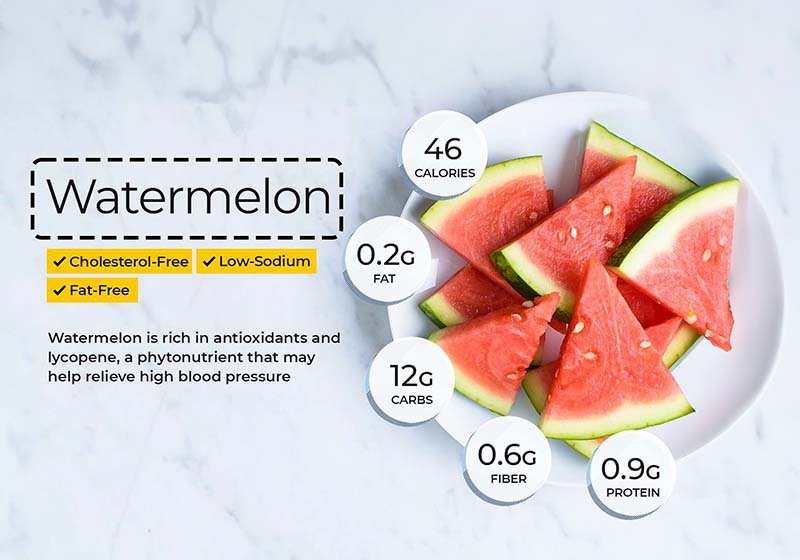
2.1 Carbs in Watermelon
Watermelon is primarily made up of sugars, with fructose being the most prevalent, followed by glucose and a trace of sucrose. It has a low fiber content. For carb tracking, precise measurement is key. For example,
1 cup of diced watermelon (152 g):
- Fiber: 0.6 g
- Sugars: 9.4 g
- Total Carbs: 11.5 g
- Net Carbs: 10.9 g
Mid-sized wedge (286 g):
- Fiber: 1.1 g
- Sugars: 17.7 g
- Total Carbs: 21.6 g
- Net Carbs: 21 g
2.2 Fiber in Watermelon
Watermelon contains about 0.4 grams of fiber per 2/3 cup (100 g) serving, making it a low source of fiber. However, its fructose content means it’s high in FODMAPs. People with fructose malabsorption may experience digestive discomfort when consuming large amounts of sugar.
2.3 Fats in Watermelon
Watermelon is virtually fat-free, containing only minimal amounts of polyunsaturated, monounsaturated, and saturated fatty acids. It’s a great non-fat option for your diet. Interestingly, watermelon seeds are edible and a source of omega-3 fatty acids.
2.4 Protein in Watermelon
Watermelon isn’t a significant source of protein, with less than 1 gram per cup. While some industries extract protein from sprouted and shelled watermelon seeds, the protein content in the seeds themselves is limited due to the hard shell.
2.5 Vitamins and Minerals in Watermelon
Watermelon is a great source of vitamin C and provides a good amount of other vitamins and minerals, including Vitamin B5 (pantothenic acid), found in nearly all foods. Vitamin C is crucial for immune function. Potassium is key for healthy blood pressure and heart function. Watermelon also contains copper, a mineral often lacking in Western diets, and is rich in beta-carotene, which your body can convert into vitamin A.
3. Health Benefits of Eating Watermelon
Watermelon isn’t just tasty; it’s also packed with good stuff that can help keep you healthy.
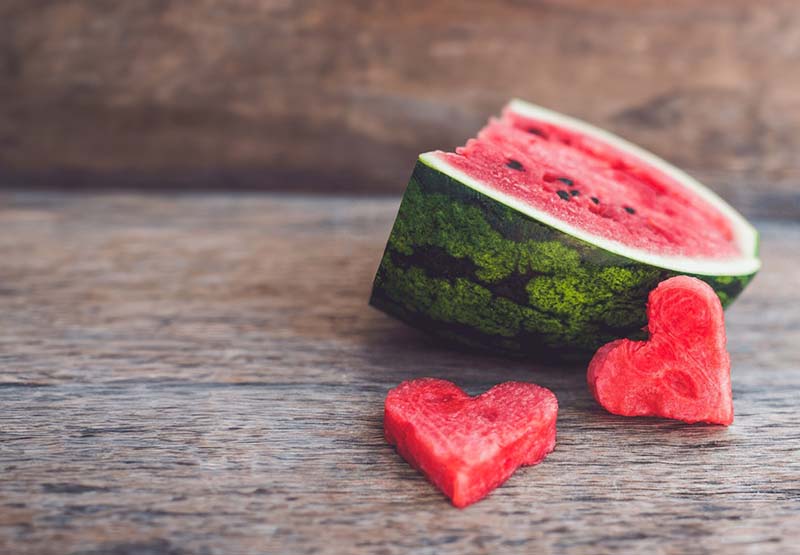
3.1 Prevents Dehydration
Even being a little dehydrated can make you feel tired and give you muscle cramps or headaches. Since watermelon is 92% water, it’s a great way to stay hydrated. After you exercise or do something strenuous, try eating some watermelon with a bit of salt. This can help bring back your body’s electrolytes (important salts) and energy. Lara Whitson, a diet expert, says watermelon is great for refreshing you and quenching your thirst.
3.2 Reduces Blood Pressure
A study in 2012 showed that something in watermelon can help lower blood pressure in people who are middle-aged, overweight, and have high blood pressure. This is because of two healthy substances in watermelon, L-citrulline and L-arginine, which help your arteries work better. Watermelon has an amino acid called citrulline that turns into arginine in your body. This helps make a gas called nitric oxide, which relaxes and widens blood vessels, helping your blood flow better and potentially lowering high blood pressure.
3.3 Contributes to Weight Loss
Choosing watermelon instead of other sweet snacks can help you feel full for longer. Christina Meyer-Jax, a nutrition expert, says this. A study in 2019 found that people who are overweight and eat watermelon instead of low-fat cookies feel more satisfied. Eating watermelon regularly was linked to lower body weight, BMI (a measure of body fat), blood pressure, and waist size.
3.4 Helps Reduce Muscle Fatigue
A small study found that athletes who drank watermelon juice had less muscle soreness for up to 24 hours after exercising. The juice also helped them recover their heart rate faster. This might be because of the L-citrulline in watermelon, which helps reduce muscle damage. More research is needed, but drinking watermelon juice after workouts could be a good idea.
4. Potential Side Effects of Eating Watermelon
While watermelon is known for its health benefits, there are some potential downsides to consider:
4.1 Abdominal Discomfort and Digestive Issues
Eating a lot of watermelon can cause stomach problems like discomfort, bloating, gas, and diarrhea. This is because watermelon is high in FODMAPs, which are a type of carbohydrate that some people find hard to digest. These carbs don’t break down easily or get absorbed slowly in your small intestine.
4.2 Potential Increase in Blood Sugar Levels
Watermelon has a high glycemic index (GI), meaning it can raise your blood sugar levels quickly. This is especially important for people with diabetes to consider. Eating too much watermelon might cause a spike in blood sugar, so moderation is key.
4.3 Possible Skin Discoloration
Eating watermelon in large amounts might lead to a buildup of lycopene in your skin. Lycopene is what gives watermelon its red color. If you have too much of it, it can make your skin turn slightly orange. This condition, called lycopenaemia, is rare and reversible. Cutting back on high-lycopene foods like watermelon can return your skin color to normal.
Note: While these issues can occur, they’re generally only a concern if you eat watermelon in very large quantities. For most people, watermelon can be a healthy part of their diet when eaten in moderation. Remember, balance is key in any healthy eating plan.
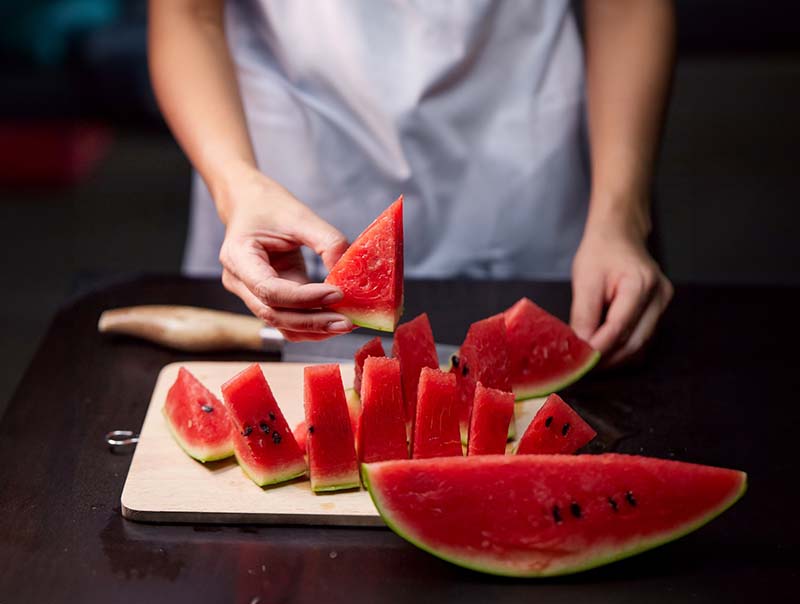
5. Varieties of Watermelon
Watermelon is a diverse fruit with many different types and cultivars available. These varieties can be categorized based on several characteristics:
- Size: There are “icebox” or smaller varieties, perfect for small families or single servings, and larger “picnic” types which are ideal for gatherings.
- Flesh Color: The flesh inside can vary in color, ranging from the traditional pink to yellow and even orange.
- Seed Content: Some watermelons have seeds, while others are bred to be seedless for easier eating.
The outer rind of watermelons is also quite varied. It can be solid green, striped with green, or have a mottled pattern with white. In terms of shape, watermelons are either round or oval and their weight can vary significantly, ranging from as little as 6 pounds to as much as 29 pounds. The most common flesh color is pinkish-red, but golden-fleshed varieties are gaining popularity for their unique taste and appearance.
Originally from tropical Africa, watermelons are now widely cultivated in the United States in warm regions like Texas, Florida, Georgia, and California. These areas offer the ideal warm climate and a long growing season that watermelons require to thrive.

6. The Best Time to Eat Watermelon
Watermelon is at its best during the summer months in the U.S., which is when it’s in season. To pick a ripe watermelon, here are a few tips to keep in mind:
- A good watermelon will feel heavy for its size. This heaviness is a sign that it’s full of juice and at peak ripeness.
- The rind should be firm and smooth. Avoid melons with nicks, dents, or bruises, as these can be signs of an overripe or damaged watermelon.
- Look at the spot where the watermelon was resting on the ground. This area, known as the ground spot, should be a creamy yellow color. If it’s white, the watermelon may not be fully ripe.
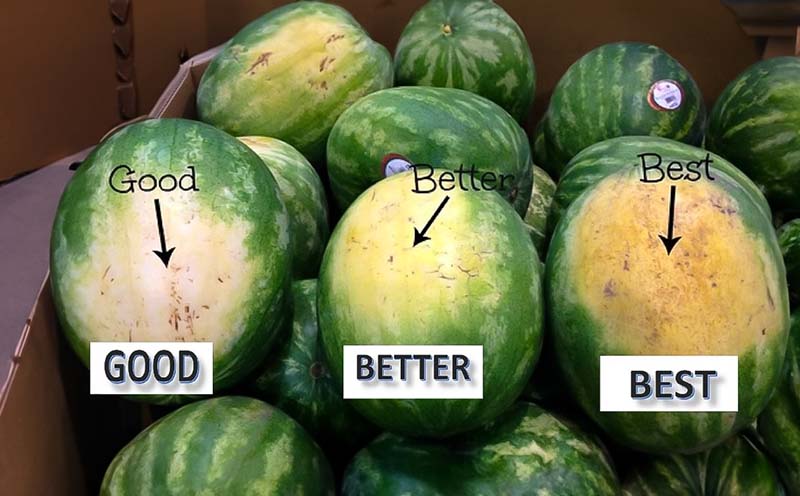
7. How to Prepare and Store Watermelon Safely?
Storing and using watermelon correctly can greatly enhance its taste and nutritional value. If you’re not planning to eat your watermelon immediately, here’s what you should do:
- Keep the whole watermelon on your countertop, away from direct sunlight. The National Watermelon Promotion Board recommends storing watermelons at around 55°F for optimal freshness.
- Don’t just stick to regular slices. Get creative and add watermelon to smoothies, salsa, and both fruit and vegetable salads for an extra burst of flavor and nutrition. Remember, the entire watermelon is edible – this includes the seeds and even the rind.
- You can also cook watermelon. Try grilling it for a unique twist or freezing it to make a refreshing dessert.
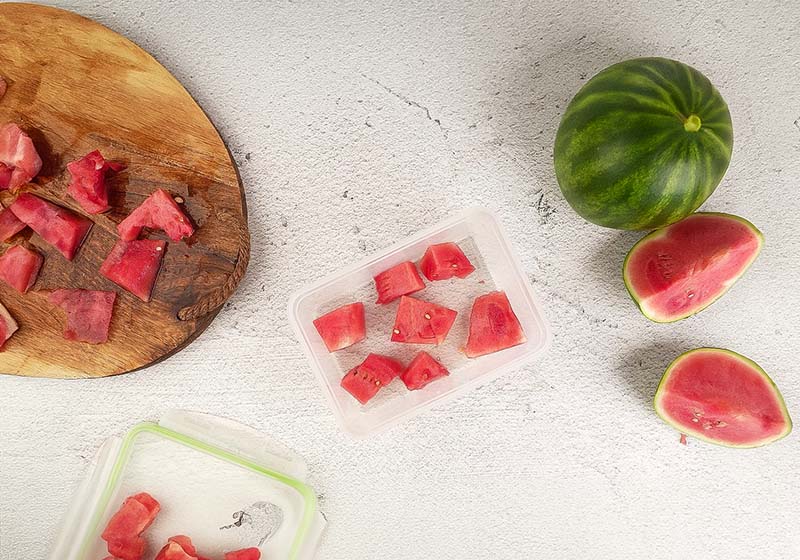
8. Conclusion
In conclusion, understanding “How Many Calories in a Watermelon“ is crucial for those mindful of their dietary choices. This juicy fruit not only offers a low-calorie snack option but also provides numerous health benefits, from hydration to aiding in weight management. Whether you’re enjoying it sliced, in a smoothie, or even grilled, watermelon is a versatile and nutritious choice for any diet.
We’d love to hear your experiences and tips on enjoying watermelon. Have you discovered any unique recipes or ways to incorporate it into your meals? Please share your stories and feedback in the comments below. For more insightful and health-focused content, don’t forget to check out more blogs from Biosculpture. Your journey to a healthier lifestyle is just a click away!


